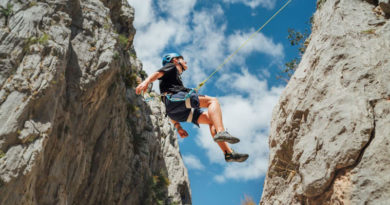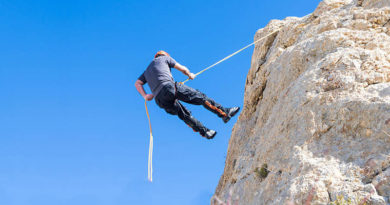How Tight Should Rock Climbing Shoes Be?
Rock climbing shoes should be tight but not too tight so that they cause pain or restrict movement. The proper fit will allow for the best climbing performance and comfort. The fit of rock climbing shoes varies depending on factors such as your climbing style, foot sensitivity, and swelling. The tightness can also be a preference thing. Some climbers like me, prefer a more snug fit while others like a more relaxed fit. I’d suggest trying models from brands until you find the one that works best for you.
Below I have outlined the universal guidelines that work for most people. So, keep reading if you want in-depth information.
The Toes Should Be Snug
The toes of the climbing shoes should be snug in the front. This will improve control and grip while climbing. Toes should not have too much space to move around freely. But they should be able to wriggle somewhat to avoid cramping. Maintaining balance and precision on the rock face requires a snug fit for the toes.
The Heel Should Be Secure
To minimize slippage while climbing, the heel of your should be secure. Maintaining balance and stability on the rock face requires a secure heel fit. If the heel is excessively loose, your foot may wander about inside the shoe, causing discomfort and making some climbing maneuvers more difficult. If the heel is overly tight, it can create pain and discomfort, which might affect your performance. It is critical to strike the correct mix between a secure fit and comfort.
The Arch Should Be Supported
The shoes should support the arch of your foot. This provides stability and aids in maintaining proper posture when climbing. A well-supported arch can also aid in the even distribution of weight and the prevention of fatigue during extended climbing sessions. The arch should not be compressed too tightly, as this might cause discomfort and impair performance. For the best climbing performance, it is critical to strike a balance between support and comfort.
The Toes Should Not Be Cramped
Cramping of the toes can be painful and have a detrimental impact on your climbing performance. It’s vital to allow enough freedom for the toes to wiggle but not so much that they can move about freely. This improves control and grip while climbing. The ideal fit will differ depending on personal preferences and foot shape, but striking a balance between a snug fit and avoiding cramping is critical for peak climbing performance.
Factors That Affect Shoe Fit
The following factors may also affect the overall fit of your shoes:
Climbing Style
Climbing style can have a significant impact on the fit of rock climbing shoes. Different climbing styles require varying degrees of precision, sensitivity, and support. Selecting the wrong shoe for your climbing style can have a significant impact on your performance and comfort.
Climbers who love sport climbing, for example, prefer a tighter, more accurate fit to improve their ability to put their feet precisely on small climbing holds. Climbers who like bouldering, on the other hand, prefer a looser, more flexible fit for better sensitivity on the rock face.
To handle the wide range of foot and toe movements required for crack climbing, crack climbers require shoes with a more neutral profile and a comfortable fit. For improved edge capabilities on small holds, traditional climbers may select a stiffer shoe with a more aggressive downturned form.
Foot Sensitivity
People with sensitive feet prefer a looser fit for greater comfort. On the other hand, People with less sensitive feet prefer a tighter fit for greater precision. If you have sensitive feet, you will experience discomfort or pain when wearing shoes that are too tight. You will also have less room in the toe box to accommodate swelling. In this case, choose a softer, more flexible shoe for greater sensitivity on the rock face.
If you have less sensitive feet, you will appreciate a tighter, more aggressive fit for improved precision and control on small holds. You could also want a stiffer, more supportive shoe for better edging. Eventually, the best fit will be determined by your specific foot sensitivity, climbing style, and personal preferences.
Foot Swelling
Foot swelling can occur for a variety of reasons. Your feet will more likely to be swollen in the evening after a long day of climbing. When feet swell, it can cause discomfort or even pain if the shoes are too tight. To allow for foot swelling, there should be enough room in the toe box of the climbing shoes. Climbers with swollen feet prefer a shoe with a looser fit or even a shoe with a more relaxed, pleasant shape. This will provide more comfort and flexibility on the rock face.
It’s also a good idea to try on climbing shoes later in the day when your feet are at their largest. You will get a better sense of the fit and account for any swelling that may occur while climbing. Therefore, the best fit will be determined by your specific foot sensitivity and swelling patterns, as well as your climbing style and personal preferences.
Break-In Period
A brand-new pair of climbing shoes will always feel tight and uncomfortable. After some use, the shoes will conform to the shape of your feet and will become comfortable. This process is known as the break-in period. During the break-in period, pay attention to the fit of your shoes and adjust them as necessary. You may need to loosen or tighten the laces, or even change to a different brand or model of shoes if the fit does not improve.
It’s also crucial to know that the break-in period varies depending on the climber and the shoe. Some shoes may become more comfortable after a few climbs, but others may take weeks or even months to fully break in. Wear your new climbing shoes around the home or on easy climbs to gradually acclimatize to the fit to assist speed up the break-in phase. To assist your shoes adjust to the contour of your foot, you can use apply shoe stretch spray or pack the toes with newspaper.
How to Adjust the Fit?
The following things you can do to further improve the fit:
Use of Toe Caps, Toe Boxes, and Heel Cups
Toe caps, toe boxes, and heel cups are features found in some rock climbing shoes that can affect the fit and performance of the shoes.
Toe caps are reinforced areas of the shoe that protect the toes and help the shoe retain its shape. Toe boxes are the front area of the shoe that covers the toes and can vary in width depending on the shoe model. A wider toe box allows more room for the toes, which is useful for climbers with wider feet or those who suffer from foot edema. On small grips, a tighter toe box might provide more precision and control.
Heel cups are shoe reinforcements that cup the heel and give support and stability. A well-designed heel cup should keep the heel firmly in place, preventing sliding and boosting edging performance. Heel cups can also aid in blister prevention and comfort, especially on long climbs.
Stretching Techniques
Rock climbing shoes might benefit from stretching procedures to increase fit and comfort. Climbers with wider feet, high arches, or other foot shapes that may not fit well in standard-sized shoes can benefit most from these techniques.
Here are a few common stretching techniques:
- Heat Stretching: To make the material more pliable, add heat to the shoes, such as by wearing them in a hot shower or using a hair drier. Now, put on these heated shoes for a few hours (make sure they are not too hot or they will burn your skin). Allow the materials to mold to the shape of your feet.
- Stretching Sprays: Stretching sprays are available that can be put on the shoes to make them more pliable and simpler to stretch. Simply spray the shoes and wear them for a few hours to expand the material.
- Toe Box Stretching: This method involves the use of a toe box stretcher, which is a device created specifically to stretch the toe box of shoes. Simply insert the stretcher into the shoe and gradually adjust it until you achieve the desired level of stretching.
- Stuffing: Stuffing the toes of the shoes with a substance, such as newspaper, helps stretch the material and enhance the fit. Allow the material to stay in the shoes overnight or for a few hours to stretch them.
It’s crucial to note that stretching procedures might permanently affect the shape and fit of your shoes. So, be cautious and only use them as needed. Furthermore, stretching procedures may not work for all shoes. So, it’s better to seek advice from a specialist or the manufacturer of your shoes.
The Right Time to Size Up
The right time to size up in a rock climbing shoe is when the shoes are too tight and cause discomfort or pain. It’s important to avoid sizing up too soon. Because loose-fitting shoes can negatively impact performance by reducing precision, control, and sensitivity on holds.
Here are a few signs that it may be time to size up in your climbing shoes:
- Pain or Discomfort: If you feel pain or discomfort in your toes or heels, it’s time to size up. This is especially true if the pain continues after the break-in time has passed.
- Foot Swelling: If your feet expand after long climbs, it’s a good idea to size up to account for the swelling. This can assist to relieve foot pressure and prevent discomfort and agony.
- Toe Crunching: If your toes are cramped or squeezed in the shoes, it could be a clue that you need to size larger. This can diminish your force and control on holds, as well as create discomfort and suffering over time.
- Loose Fit: If you can easily slip your foot out of the shoe when you perform the slip test, or if the shoes feel loose on your feet, it may be time to size down.
It’s essential to remember that sizing up too quickly will have a negative impact on your performance. Wait until you’re in discomfort or pain before sizing up.




